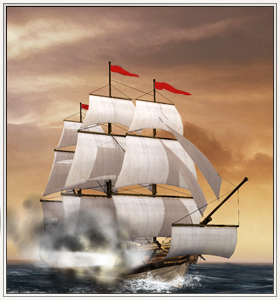Difference between revisions of "Carronade Frigate (ETW Unit)"
CoconutFred (talk | contribs) m (categories) |
|||
| Line 1: | Line 1: | ||
| − | {{Unit|image=[[Image:Carronade frigate.png]]|Class=6th Rate|Men=76| | + | {{Unit|image=[[Image:Carronade frigate.png]]|Class=6th Rate|Men=76|Weaponry=24 guns|Minimum Building Requirement=Drydock|Region=Global|Recruitment Cost=1170|Upkeep Cost=290|Technology Needed=Carronades}} |
==Overview== | ==Overview== | ||
Revision as of 15:17, 13 July 2011
Overview
Normally frigates would be armed with long guns, probably no larger than 12-pounders. A few short-barrelled 64-pounder carronades might be aboard to give a close-in broadside more weight of shot. A carronade frigate goes one better, and carries nothing but carronades – short guns that are half the weight of the equivalent conventional cannon. While the weight of a broadside is truly awesome, the frigate has to get in close in order to blow an enemy to smithereens thanks to the carronades’ limited range. A clever enemy will stay out of range of the carronades’ horrendous power and take long range pot shots.
Historically, only the Royal Navy experimented with an all-carronade armament aboard HMS Glatton (in service from 1795). Glatton carried 28 64-pounder and 28 32-pounder carronades, giving a weight of fire that was more than 17% greater than HMS Victory could deliver at the Battle of Trafalgar! This massive firepower allowed her, on one occasion, to chase all eight vessels in a French squadron back into port. Oddly enough, the next two vessels to carry the name “Glatton” in RN service were also massively over-armed.
